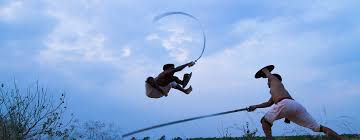African Martial Arts: Istunka
- Amir Hamza
- Jul 1, 2020
- 3 min read
Updated: Jul 3, 2020
When it comes to martial arts, its not surprising to find so much of it connected to the Far East of Asia since Kung Fu films popularised it through Bruce Lee (R.I.P) as well as many Japanese and American video games series (like Capcom's Street Fighter, Neatherrealms Mortal Kombat) that exploited the popularity of it. While it is typically a diverse industry, there is no shortage of Japanese, Chinese and American characters who typically practice an eastern martial art (such as Karate or Kung Fu). But there are several regions in the world that go unnoticed and we want to cover these martial arts styles, how much representation they get and the potential they have to be used in future media.
Starting us off we are looking at Martial arts from the continent of Africa. With the release of Black Panther film back in 2016, it is no surprise that the cast and crew of the film did heavy research into the variety and diverse cultures in Africa, giving us somewhat a mixed and match Pan-African culture. We are pretty sure the martial arts styles in Africa can be very diverse as well.

Martial Art: Istunka/Dabshid
Style: Weaponry
Country: Somalia (East African)
Origin: Ajuran Period/Sultanate of the Geledi
History: This stick fighting martial art style was initially developed in the Arujan Period (13th - 17th century). It was then centralised into a tournament during the Sultanate of the Geledi(or Gobroon Dynasty) under Sultan Ahmed Yusuf during the 19th century. The martial art is performed as a mock fight around the start of Somali New Year in the region of Afgooye (on the bank of the Shebeele River). Traditionally opposing tribes would fight in full combat gear with weapons ranging from Axes, daggers and swords. But for safety only use sticks in the modern era.

Culture: The practice of Instunka/Dabshid as a ritual is believed to have a significant connection to fortune. failure to stage the event would lead famine, plague and drought among other omens. But on to something more positive: A three day festival takes place for the event consisting of Shirib (songs and chants), with Day 1 being nothing but Shirib and marching to the local Suldans home to join the festival, Day 2 is when the actual fight performance takes place, whilst Day 3 is a feast and more Shirib. A bonfire called the "Dabshitka" takes place where the people gather sticks and hay to ignite and then leap over to bring good fortune and overcome struggles as well as gain confidence.
Warrior: The Warrior garb consists of a Macawis (Ma'awiis or Ma'wis) a Sarong/Lungi like clothing with a shawl called a Garbassar. Amulet and necklace can also be worn. Some fighters will carry a blanket which they use for defensive or evasion to block strikes, conceal their weapons before striking or the grab and manipulate their opponents. (similar to Italian Rapier and Cloak or Argentina's Esgrima Criolla/Poncho y Daga).

Media/Potential: Whilst there is no famous modern practitioners, films, TV or video game characters to highlight the potential of this style. We can definitely see the parallels between how this art could work as a modern fighting style and compare it to the Wakandan Border Tribe in the Black Panther film as their Cloaks are lined with Vibranium nano tech to shield and conceal themselves and use of their curved swords (possibly based off the Ehtiopian Shotel or the Southern African Mambele) similar to the sticks. But a traditional Somali blade would be the Billao/Belawa, a short sword with a double edged leaf shaped asymmetrical blade and three prongs/horns on the hilt of the handle. (Which is the most likely bladed weapons used in the Ajuran Period). Here's a clip of the Border Tribe fighting against Black Panther, the Dora Milage and the Jabari Tribes, using their cloaks and force fields can be interesting and futuristic way to implement the Somali martial art into a modern video game like Overwatch or a fighting game.



Comments